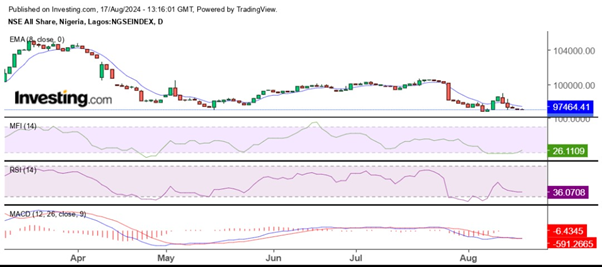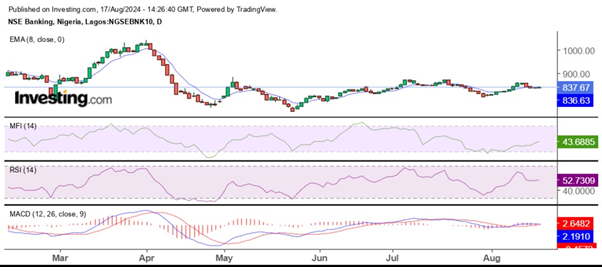NGX Formed A Double Bottom Amidst Negative Outing, Mixed Macroeconomic data

Expectations were high last week that the Nigerian equity market could trade above the 99,000 psychological line largely based on the continued bullish performance of such stocks like Oando, Julius Berger, and MTNN.
However, the market’s performance diverged from these projections, as Oando experienced a decline for three consecutive sessions, while both MTNN and Julius Berger reported weaker performance than anticipated. These were despite recent positive developments, such the announcement that MTNN has acquired the entire minority shares in MoMo, Payment Service Bank, its subsidiary, or that Julius Berger secured a substantial government contract to dualize the 82km Abuja-Kano Road.
The market experienced a downward trend for four consecutive trading sessions before ending flat on Friday. The week commenced with the Nigerian Exchange’s All-Share Index (ASI) at 98,592.12 basis points, leaving the index with a year-to-date (YTD) gain of 31.85%. Market capitalization within the period stood at N55.98tr.
By the week’s end, both the ASI and market capitalization had lost 1.51%, closing at 97,100.31bps, and N55.132tr, respectively. This decrease brought the YTD gain down to 29.86%. The week’s decline resulted in a significant reduction in the value of investor portfolios, with a total loss of N845.3 billion.
The performance of various sector indices revealed a mixed picture for the month, with the oil and gas sector chalking a robust 8.94%, highlighting strong performance within the industry. The banking sector also performed well, returning 4.52%, ahead of the Pension sector’s 3.48% gain, just slightly better than the Insurance sector’s 3.42% return. The Consumer Goods sector also witnessed a modest 2.25% growth, while on the other hand, the Industrial Goods sector recorded a notable decline of 8.62%, indicating challenges within the sector that reflects the broader market concerns about the developments in the sector.
Among the top gainers, RT Briscoe, a services company with a market capitalization of N1.99bn, specializes in the sales and servicing of Toyota and Ford vehicles, along with technical equipment, mining and drilling machinery, and power generators stoodout, posting a remarkable 33.86% growth. The company’s strong performance suggests positive investor sentiment and confidence in its future prospects.
Other notable gainers included Total Energies Marketing Nigeria Plc which saw it rise by 19.69%, followed by Julius Berger’s 18.18% increase; Guinea Insurance, 17.65%; and University Press, 12.39%. These companies demonstrated a significant increases in stock prices, reflecting favorable market conditions or positive company-specific news.
On the downside, the top decliners included Cutix, a key player in the manufacturing and marketing of electrical, automotive, and telecommunications wires and cables, experienced a substantial decrease in its stock value, shed 17.50%. Other major decliners were BUA Cement, which lost 14.82%; Oando, 11.70%; Learn Africa, 10.89%; and Chams Holdings, 10.22%. These declines contributed to the overall negative market performance for the week.
However, Julius Berger is expected to be a focal point in the coming week. NeptuneHill, a prominent shareholder, recently acquired 6,294,445 units of JBN at N130 each, totaling N818.3m. Such a significant purchase by a major investor often signals confidence in the stock’s potential for growth. When large shareholders increase their stakes, it is typically seen as a positive indicator that the stock is poised for future appreciation.
In economic news, Nigeria’s headline inflation rate fell in July for the first time in 19 months, dropping to 33.40% from 34.19% in June. On a month-to-month basis, inflation was recorded at 2.28%, slightly lower than the 2.31% observed in June. This decline is attributed to the government’s decision to suspend VAT on certain food imports, which has helped mitigate some inflationary pressures. The marginal decrease in inflation suggests that the aggressive interest rate hikes of the past may be coming to an end. Future monetary policy could potentially focus on holding rates steady or making a slight reduction if inflationary pressures continue to ease. Business activities in the month July contracted as revealed by CBN Purchasing Manager Index (PMI) at at 49.7 points, extending its contraction spell to a thirteenth straight month though with a slight improvement over June’s reading (44.8 points). The underwhelming reading of the composite PMI in July was largely driven by weak sentiment in the agriculture (49.7 points) and industry (48.3 points) sector. Precisely, new orders and employment level faltered across these business segments – an unsurprising development given the dual shocks of exchange rate and energy goods price volatility over the last 12 months, which are core to activities in these segments.
Meanwhile, for the second month in a row, the services sector PMI was upbeat (albeit modest) registering 50.3 points print vs 50.1 points in June. However, key indicators within the sector exhibited mixed performance. While business activity and stock of raw materials inventory expanded, the level of new orders contracted during the review period. Notably, employment levels remained stagnant. A closer look at the sectoral composition reveals a mixed performance, with eight of the fourteen subsectors growing and six contracting. The Motion Pictures and Music Production subsector led with the highest expansion to 58.2 points (previously: 51.0 points), while the Management of Companies subsector saw the largest decline to 42.3 points (previously: 49.3 points).
NGXASI Daily Chart Forming Double Bottom
Currently, the market is trading below the T-Line (8-Day Moving Average), largely due to profit-taking activities in Oando and other high-cap stocks, despite which the market has formed a double bottom pattern, indicating strong support levels. This technical pattern typically signals a bullish reversal, suggesting that the market may be poised for an upward movement. Supporting this view, the Relative Strength Index (RSI) stands at 36, indicating that the market is in an oversold condition. The Moving Average Convergence Divergence (MACD) is also showing signs of an uptrend, reinforcing the potential for a positive shift in market sentiment. These technical indicators sign that an uptrend might be imminent. Given the strong earnings reports, favorable market news, and emerging rumors, there is optimism that the market index may experience an upward trajectory in the coming week. Investors are advised to watch for further developments and adjustments in market conditions that could influence future performance.
NGX Oil & Gas Index Chart

This sector is experiencing an unprecedented peak with the index reaching an all-time high of 1,656.55 points. This impressive figure is accompanied by a robust money flow reading of 86.16, which reflects strong investor confidence and interest in this distinguished sector. The Relative Strength Index (RSI) is currently at 87, indicating that the market is in an overbought territory. Additionally, the Moving Average Convergence Divergence (MACD) is positioned above the signalling line, suggesting a powerful upward momentum.
A significant driver of this sector’s recent performance is the notable rise in Seplat’s share price, which surpassed N4,000 on Thursday. This surge has contributed to pushing the sectoral index higher. Furthermore, Oando’s shares have been on a bullish streak for more than eight consecutive sessions, further bolstering the index’s upward trajectory.
The sector has demonstrated impressive returns over various periods, with year-to-date (YTD) gain of 58.82%; a quarter-to-date (QTD) increase of 14.98%; and a week-to-date (WTD) rise of 8.94%. These figures highlight the sector’s strong performance and resilience. Given these indicators, the sector appears well-positioned for continued growth in the coming week. The combination of high investor confidence, strong technical signals, and recent stock performance suggests a favourable outlook for the sector’s future trajectory.
NGX Banking Index Chart

The banking sector index has been in a state of consolidation for nearly three consecutive months, despite various efforts to bolster the sector including public offerings and rights issues aimed at strengthening the capitalizations of various players, which have not led to significant improvements. The recent imposition of a 70% one-off tax on foreign exchange (FX) transactions has further eroded investor confidence in this sector. The market’s response to these developments suggests that stocks within this sector may either be overvalued or trading below their issue prices, which undermines their attractiveness to value-seeking investors. Currently, the banking sector—a major segment comprising large financial institutions—has experienced a negative year-to-date (YTD) return of -6.44%. Despite a modest month-to-date (MTD) gain of 4.52%, the sector has faced a negative week-to-date (WTD) return of -2.28%.
The sector’s recent performance highlights the broader issue of sectorial rotation, as investors have shifted their focus and investments to more active sectors. This shift has negatively impacted the sector with funds and capital flowing into other areas perceived as more promising. A critical factor contributing to the sector’s struggles is the 70% one-off windfall tax on FX transactions, which has placed additional strain on financial institutions and dampened overall investor sentiment. To restore confidence and encourage investment, it is essential for the Federal Government to reconsider and potentially revise this tax policy. Currently, the sector’s money flow reading stands at 43.6, indicating a moderate level of investment activity. The Relative Strength Index (RSI) is at 52.7, suggesting that the sector is in a state of expansion, though this could swing either positively or negatively depending on future developments. Additionally, the Moving Average Convergence Divergence (MACD) is slightly above the signal line, signalling a tentative upward momentum.
For the banking sector to regain its prominence and attract renewed investment, addressing the unfavourable FX tax policy is crucial. A revision of this tax could provide the necessary tonic for the sector’s recovery and growth, potentially reversing its current negative trends and positioning it for a more favourable outlook in the future.





